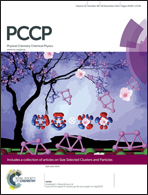Structures and energies of Cu clusters on Fe and Fe3C surfaces from density functional theory computation†
Abstract
Spin-polarized density functional theory computations have been carried out to study the stable adsorption configurations of Cun (n = 1–7, 13) on Fe and Fe3C surfaces for understanding the initial stages of copper promotion in catalysis. At low coverage, two-dimensional aggregation is more preferred over dispersion and three-dimensional aggregation on the Fe(110) and Fe(100) surfaces as well as the metallic Fe3C(010) surfaces, while dispersion is more favorable over aggregation on the Fe(111) surface. On the Fe3C(001) and Fe3C(100) surfaces with exposed iron and carbon atoms, the adsorbed Cu atoms prefer dispersion at low coverage, while aggregation along the iron regions at high coverage. On the iron surfaces, the adsorption energies of Cun (n = 2–7) are highest on Fe(111), medium on Fe(100) and lowest on Fe(110). On the Fe3C surfaces, the adsorption energies of Cun (n = 1–3) are highest on Fe3C(100), medium on Fe3C(010) and lowest on Fe3C(001), while, for n = 4–7 and 13, Fe3C(010) has stronger adsorption than Fe3C(100). On the basis of their differences in electronegativity, the adsorbed Cu atoms can oxidize the metallic Fe(110), Fe(100) and Fe3C(010) surfaces and become negatively charged. On the Fe3C(001) and Fe3C(100) surfaces with exposed iron and carbon atoms, the adsorbed Cu atoms interacting with surface carbon atoms are oxidized and positively charged. Unlike the most stable Fe(110) and Fe3C(001) surfaces, where the Fe(110) surface has stronger Cu affinity than the Fe3C(001) surface, which is in agreement with the experimental finding, the less and least stable Fe3C(010) and Fe3C(100) surfaces have stronger Cu affinities than the Fe(110) and Fe(100) surfaces. Since less stable facets are not preferably formed thermodynamically, it is crucial to prepare such surfaces to explore Cu adsorption and promotion, and this provides challenges to surface sciences.


 Please wait while we load your content...
Please wait while we load your content...